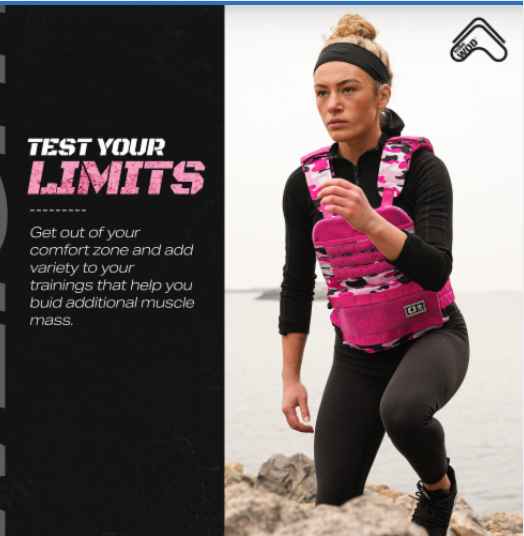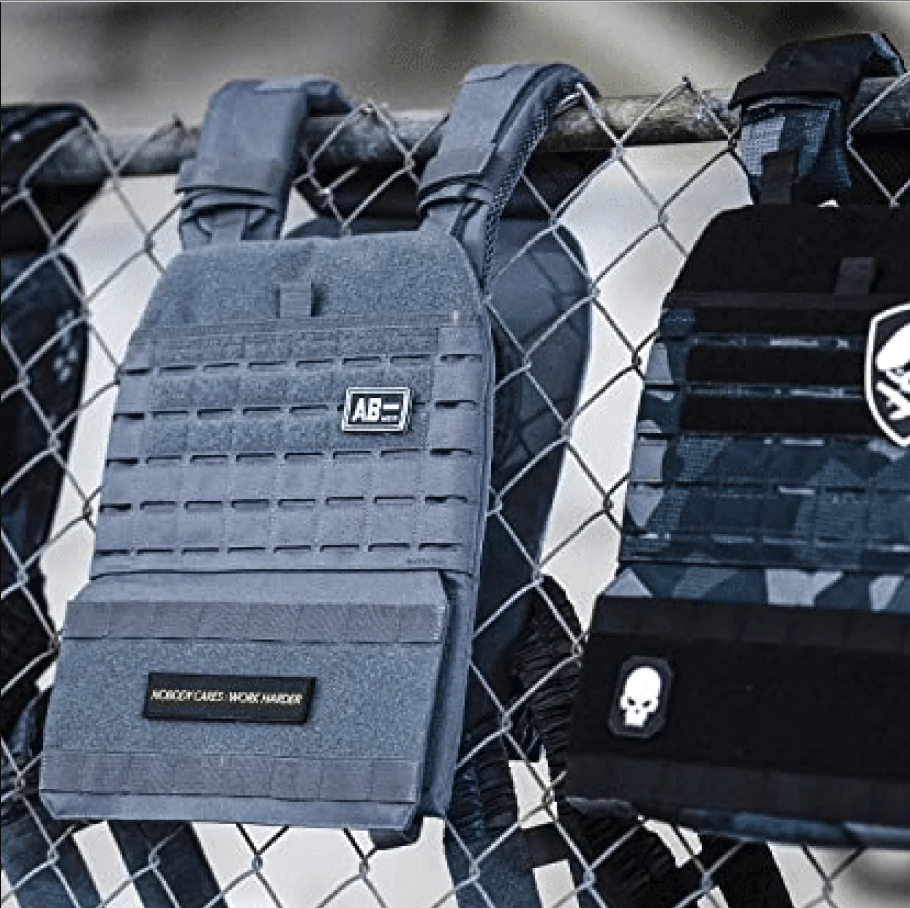In the realm of lower body exercises, lunges stand as pillars of strength and stability. Whether you're aiming to build muscle, improve balance, or enhance athletic performance, lunges have long been a go-to choice. But what happens when you add an extra challenge? Enter weighted vest lunges – a dynamic exercise that takes your leg day to a whole new level.
In this comprehensive guide, we'll delve into the intricacies of weighted vest lunges, exploring their benefits, proper form, variations, and how to incorporate them into your fitness routine effectively. By understanding the science behind this exercise and mastering its execution, you can unlock a multitude of benefits for your lower body strength, stability, and overall fitness level. So, grab your weighted vest and get ready to elevate your leg day routine like never before.
Understanding Weighted Vest Lunges
Weighted vest lunges are a variation of the classic lunge exercise, where you add additional resistance by wearing a weighted vest. This added challenge intensifies the workout, targeting the muscles of the lower body, including the quadriceps, hamstrings, glutes, and calves, while also engaging the core for stability.
The use of a weighted vest adds a unique dimension to lunges by distributing the added weight evenly across the body. Unlike holding dumbbells or other external weights, which can sometimes disrupt balance and form, a weighted vest allows for a more natural movement pattern, ensuring that the resistance is evenly distributed and the focus remains on proper lunge technique.
By incorporating weighted vest lunges into your workout routine, you not only enhance lower body strength and muscle definition but also improve overall functional fitness. The dynamic nature of lunges mimics real-life movements, making them particularly effective for athletes and individuals looking to improve their agility, balance, and coordination.
In the following sections, we'll explore the proper form and technique for performing weighted vest lunges, as well as various modifications and progressions to keep your workouts challenging and effective. Whether you're aiming to build muscle, boost endurance, or enhance athletic performance, incorporating weighted vest lunges into your fitness routine can help you reach your goals faster and more efficiently.
Benefits of Weighted Vest Lunges
- Increased Intensity, One of the primary benefits of weighted vest lunges is the heightened intensity they provide. By adding resistance with the weighted vest, you effectively increase the workload on your muscles, forcing them to work harder. This increased intensity stimulates greater muscle activation, leading to improved strength and muscle development in the lower body. Over time, this can lead to noticeable gains in muscle size, strength, and endurance.
- Improved Stability, Weighted vest lunges require a greater degree of balance and coordination compared to traditional lunges. As you navigate the added resistance, your muscles must work in harmony to maintain proper form and stability. This not only strengthens the muscles of the lower body but also enhances overall stability and proprioception (the body's awareness of its position in space). Improved stability can translate to better performance in various physical activities and reduce the risk of injury in daily life.
- Functional Strength, Lunges are inherently functional exercises, as they closely mimic the movements involved in everyday activities such as walking, climbing stairs, and bending down. By adding a weighted vest to lunges, you further enhance their functional benefits. The increased resistance challenges the muscles in a way that closely resembles real-life movements, helping to build functional strength that translates seamlessly to daily tasks and sports performance.
- Versatility, Weighted vest lunges offer a high degree of versatility, allowing for endless variations to target different muscle groups and accommodate various fitness levels. Whether you're looking to focus on the quadriceps, hamstrings, glutes, or calves, there's a weighted vest lunge variation to suit your needs. Additionally, the adjustable nature of weighted vests makes it easy to modify the resistance level, making this exercise accessible to individuals of all fitness levels, from beginners to advanced athletes.
- Cardiovascular Conditioning, In addition to their strength-building benefits, weighted vest lunges also provide a cardiovascular workout. The increased resistance elevates your heart rate, effectively turning the exercise into a cardiovascular conditioning activity. This dual emphasis on strength and cardiovascular conditioning makes weighted vest lunges a time-efficient option for improving overall fitness and burning calories.
Incorporating weighted vest lunges into your workout routine can lead to a wide range of benefits, from increased muscle strength and stability to improved functional fitness and cardiovascular health. Whether you're aiming to build muscle, enhance athletic performance, or simply improve your overall health and well-being, weighted vest lunges are a versatile and effective exercise choice.
Which Muscles are worked during weighted vest lunges?
Weighted vest lunges are a compound exercise that primarily target the muscles of the lower body, including:
- Quadriceps: The quadriceps muscles, located at the front of the thigh, are heavily engaged during lunges, especially when stepping forward or performing walking lunges.
- Hamstrings: The hamstrings, located at the back of the thigh, play a significant role in controlling the descent and providing stability during lunges, particularly in reverse lunges.
- Glutes: The gluteal muscles, including the gluteus maximus, medius, and minimus, are actively engaged to stabilise the hips and control movement during lunges. They are particularly involved in both forward and reverse lunges.
- Calves: The calf muscles, including the gastrocnemius and soleus, assist in stabilising the ankle and providing support during lunges, especially when pushing off to return to the starting position.
- Core: The core muscles, including the abdominals, obliques, and lower back muscles, play a vital role in stabilising the torso and maintaining proper posture throughout the lunge movement. Engaging the core helps prevent excessive forward or lateral movement of the torso and enhances overall stability.
In addition to these primary muscles, weighted vest lunges also engage various stabiliser muscles, including those of the hips, lower back, and shoulders, to maintain balance and control throughout the exercise. By incorporating weighted vest lunges into your workout routine, you can effectively strengthen and tone the muscles of the lower body while improving overall stability and functional strength.
How to do lunges with a weighted vest?
Starting Position: Stand tall with your feet hip-width apart, wearing the weighted vest securely.
Lunge Execution: Take a large step forward with one foot, lowering your body until both knees are bent at a 90-degree angle, with the back knee hovering just above the ground.
Alignment: Ensure that your front knee stays aligned with your ankle and does not extend past your toes. Keep your torso upright and your core engaged throughout the movement.
Pushing Back: Push through the heel of your front foot to return to the starting position, engaging the muscles of the lower body as you rise.
Breathing: Inhale as you lower into the lunge and exhale as you push back to the starting position.
Repetition: Perform the desired number of repetitions on one leg before switching to the other leg.
Variations of Weighted Vest Lunges
Forward Lunges
This classic lunge variation involves stepping forward with one leg and lowering the body until both knees are bent at approximately 90-degree angles. By stepping forward, you primarily target the quadriceps, hamstrings, and glutes. The weighted vest adds resistance, intensifying the muscle engagement and enhancing the effectiveness of the exercise for lower body strength development.
Benefits of Forward Lunges
- Muscle Engagement: Targets quads, hamstrings, and glutes.
- Improves Stability: Enhances balance and coordination.
- Functional Strength: Mimics everyday movements for practical strength.
- Versatile: Easily modified for different fitness levels and can be done anywhere.
Reverse Lunges
In contrast to forward lunges, reverse lunges involve stepping backward with one leg and lowering the body into a lunge position. This variation places greater emphasis on the glutes and hamstrings, while still engaging the quadriceps. Reverse lunges also require balance and stability, making them an excellent choice for targeting the posterior chain muscles while improving overall lower body strength and stability.
- Stand with feet hip-width apart, hands on hips or holding weighted vest straps.
- Take a step backward with one leg, bending both knees to lower your body.
- Push through the front heel to straighten legs, returning to start. Alternate legs.
Benefits of Reverse Lunges
- Muscle Engagement: Targets quads, hamstrings, and glutes for a full lower body workout.
- Balance and Stability: Challenges balance and coordination, improving stability.
- Joint-Friendly: Distributes load evenly, reducing stress on knees.
- Functional Movement: Mimics everyday actions like stepping back or climbing stairs, enhancing mobility and agility.
Walking Lunges
- Stand with feet hip-width apart and hands on hips or holding weights. Keep your core engaged and chest lifted.
- Take a large step forward with one leg, lowering your body until both knees are bent at 90-degree angles. Ensure your front knee is directly above your ankle and your back knee is hovering just above the ground.
- Push off your front foot and bring your back leg forward to meet the front leg, then immediately step forward with the opposite leg into another lunge. Continue alternating legs as you walk forward.
- Continue the walking lunges for a desired number of repetitions or distance.
Benefits of Walking Lunges
- Lower Body Strength: Targets quadriceps, hamstrings, glutes, and calves for improved lower body strength and muscle tone.
- Core Stability: Engages core muscles to maintain balance and stability throughout the movement.
- Cardiovascular Endurance: Elevates heart rate and provides a cardiovascular workout, enhancing overall endurance and calorie burn.
Side Lunges
How to Do Side Lunges
- Stand with feet hip-width apart.
- Step to the side, bending one knee while keeping the other leg straight.
- Push off the bent leg to return to the starting position.
Benefits of Side Lunges
- Muscle Engagement: Targets adductors, abductors, quadriceps, hamstrings, and glutes.
- Improved Mobility: Enhances hip mobility and flexibility.
- Stability and Balance: Strengthens stabiliser muscles for better balance.
- Functional Fitness: Mimics everyday movements for practical strength gains.
- Incorporating these variations of weighted vest lunges into your workout routine can help target different muscle groups, prevent boredom, and provide a well-rounded lower body workout. Whether you're aiming to build muscle, improve balance, or enhance functional strength, these variations offer a versatile and effective way to challenge your lower body muscles and take your fitness to the next level.
Incorporating Weighted Vest Lunges into Your Workout Routine
- Warm-Up: Begin your lower body workout with a dynamic warm-up to prepare your muscles and joints for exercise.
- Main Workout: Incorporate weighted vest lunges into your routine as a primary or secondary lower body exercise, performing 2-4 sets of 8-12 repetitions per leg.
- Progressive Overload: Gradually increase the weight of the vest or the number of repetitions as you become stronger and more proficient in the exercise.
- Rest and Recovery: Allow adequate rest between sets and days of training to promote muscle recovery and prevent overtraining.
- Cool Down: Finish your workout with static stretching and foam rolling to aid in muscle recovery and flexibility.
Conclusion
Weighted vest lunges offer a challenging and effective way to strengthen and sculpt your lower body, enhancing both muscle size and functional fitness. By incorporating proper form, technique, and variations into your workout routine, you can maximise the benefits of this dynamic exercise and take your leg day to new heights.The versatility and effectiveness of weighted vest lunges make them a valuable addition to any lower body workout regimen.
Whether you're aiming to build muscle, improve balance, or enhance overall athleticism, this exercise delivers results when performed with dedication and consistency. So, embrace the challenge, stay focused on form, and let the weighted vest lunge become a cornerstone of your fitness journey. With each step forward, you're not just strengthening your legs,you're forging a path toward a stronger, fitter, and more resilient version of yourself. So, strap on that weighted vest, step forward with confidence, and lunge your way to a stronger, fitter you.










